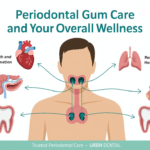What is the Difference Between Porcelain Veneers vs. Composite Veneers?
You may consider dental veneers for numerous reasons. You can get individual dental veneers for specific teeth to conceal or fix various cosmetic concerns, such as chips and cracks, stains, misalignment, gaps between teeth, and more. You can also receive a full set of porcelain or composite veneers for a smile makeover. Whether you want to conceal specific cosmetic problems or transform your smile, you have to decide on the ideal material for your dental veneers. You have two dental veneer materials to choose from — porcelain veneers vs. composite veneers. Before discussing the unique differences between porcelain veneers and composite veneers, let’s discuss a few basic concepts. A dental veneer is a tooth-shaped and tooth-colored chip attached to the front face of your tooth. It essentially replaces the enamel of your tooth and transforms the external appearance, but it offers no functional benefits. Porcelain veneers are made of thin shells of porcelain, whereas composite veneers are made of engineered resin. Both types of dental veneers improve your smile, but which is better? Below, we highlight the differences between porcelain veneers and composite veneers.Composite vs. Porcelain Veneers: Time
Composite veneers usually take less time than porcelain veneers. Your dentist can provide composite veneers during one chairside procedure, whereas porcelain veneers are done over at least two sessions. Below, we describe what you can expect from the composite veneers and porcelain veneers processes. During your session for composite veneers, the dentist will match the composite resin to your teeth, ensuring the ideal shade and color for the veneers. The dentist will attach the composite resin material to your teeth, following which laser energy is used for curing. After applying composite resins, the dentist will polish the resin, and you can walk out of the dental clinic with a transformed smile! During your session for porcelain veneers, the dentist will take impressions of your teeth, select the ideal color, and shave off a few millimeters of enamel from your teeth. After preparing your teeth, the dentist will take impressions and send them to the laboratory. The laboratory will prepare the porcelain veneers, and the dentist will attach them to your teeth during the second session. Porcelain veneers take at least two sessions.Verdict: composite veneers are quicker
The entire composite veneer process can be completed in one dental visit, allowing you to walk out with the perfect set of teeth. The entire porcelain veneer process takes at least two to three sessions, depending on the number of veneers you’re receiving. As such, Composite veneers are quicker.Composite vs. Porcelain Veneers: Durability
Porcelain veneers are significantly more durable than composite veneers. With proper care and maintenance, you can make porcelain veneers that last up to 15 years, but composite veneers have a lifespan of a maximum of 8 years. Below, we highlight the differences in the longevity of porcelain veneers and composite veneers. Composite veneers have a lifespan of 4 to 8 years. They’re more likely to chipping and cracking because of external pressure. If your composite veneer is chipped, you need another dental visit to restore the composite resin material. Porcelain veneers have a lifespan of 10 to 15 years. Porcelain is extremely strong when it’s bonded to a natural tooth — porcelain veneers withstand the same bite force as natural enamel, so they’re just as resistant to chipping. However, if your porcelain veneer is chipped, it will have to be replaced.Verdict: porcelain veneers last longer
Porcelain veneers have a lifespan of up to 15 years, and composite veneers have a lifespan of up to 8 years. That means porcelain veneers are more durable and last longer, and they’re also more resistant to chipping or cracking because of normal amounts of pressure. However, porcelain veneers are also harder to replace.Composite vs. Porcelain Veneers: Aesthetics
Porcelain veneers represent the gold standard in dental veneers, whereas composite veneers look a little more artificial. If you’re looking for completely natural-looking results, you need to get porcelain veneers. Below, we highlight the unique aesthetic advantages of porcelain veneers over composite resin veneers. Porcelain has the same texture and shade as natural enamel. It also matches the translucency of natural enamel, so it catches the light in similar ways to a natural tooth, ensuring completely natural results. Furthermore, the porcelain veneer can be shaded according to your desired goals, helping you achieve natural-looking white teeth. Porcelain veneers are also non-porous, so they can’t catch stains, so they won’t get discolored after a specific period. Composite resin also looks natural, but it’s not as realistic as porcelain veneers. You can get composite resin veneers for a few individual teeth, but composite isn’t the best material for full-mouth dental veneers. Your dentist can shade composite veneers according to your desired goals, but composite also gets discolored over time. If you consume a lot of tea or coffee, your composite veneers will eventually get yellowed.Verdict: porcelain veneers look more natural
Porcelain veneers are the most natural-looking replacements for natural enamel. They are indistinguishable from natural teeth, have the same properties as enamel, and they’re resistant to stains. Meanwhile, composite resin veneers are more prone to staining, and they’re not as natural-looking as porcelain.Composite vs. Porcelain Veneers: Cost
Porcelain veneers are generally considerably more expensive than composite veneers. They involve more work from dentists and dental laboratories, and the cost of replacing porcelain veneers is also higher. The specific cost of porcelain veneers will depend on your unique condition and requirements. Composite veneers are cheaper, but most people believe porcelain veneers are worth the higher cost.Dental Veneers in Houston
URBN Dental is led by highly-skilled cosmetic dentists specializing in the latest and safest dental veneers procedures. They carefully examine your facial anatomy, discuss your goals, and recommend the ideal dental veneers for you — porcelain veneers or composite veneers. Please schedule an appointment to determine if you’re a suitable candidate for dental veneers in Houston.URBN Dental Services in Houston, TX
Houston | Katy | Montrose | West University Place | Greater Third Ward | Greater East End | North East Houston | Houston Heights | Central Northwest | Fairbanks | Acres Home | East Houston | Southeast Houston | Central Southwest | Fort Bend Houston | Brays Oaks | Meyerland Area | Sharpstown | Alief | Westchase | Memorial | Northwest Houston | Katyland | Whispering Lakes | Pine Lakes | Woodcreek Reserve















